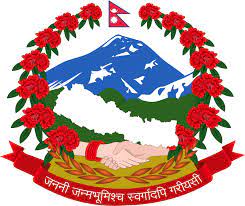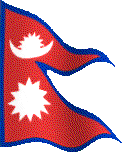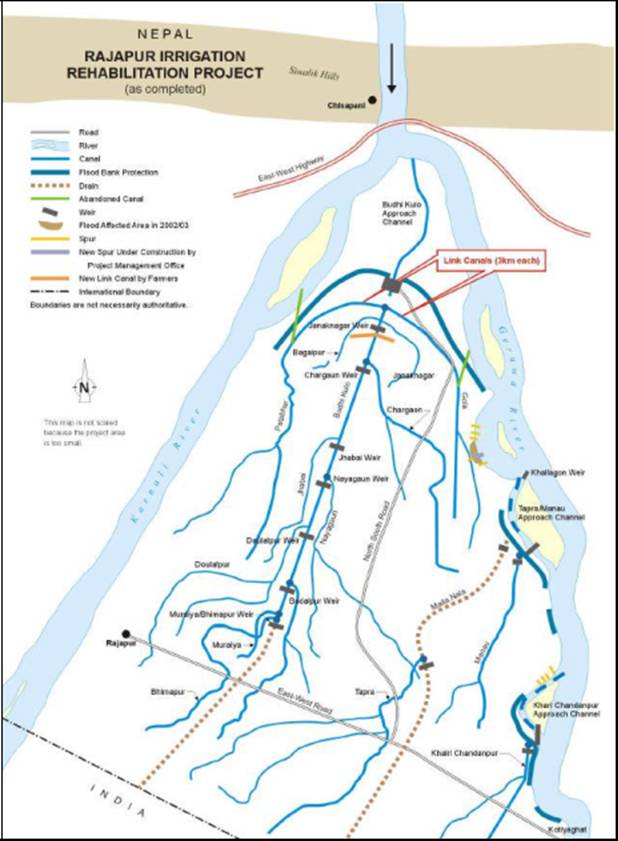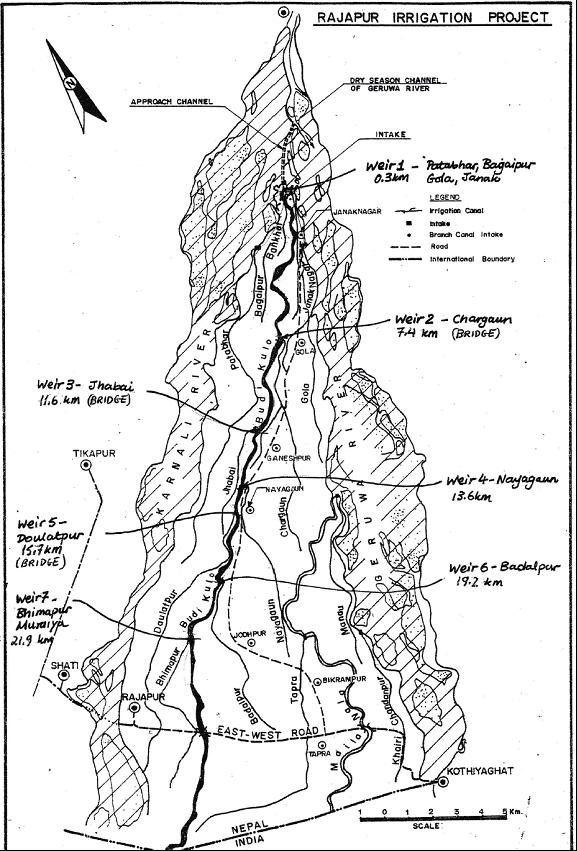नेपाल सरकार
उर्जा, जलश्रोत तथा सिंचाई मन्त्रालय
जलश्रोत तथा सिंचाई विभाग
राजापुर सिंचाई व्यवस्थापन कार्यालय
राजापुर बर्दिया
ताजा सुचना

राजापुर बर्दिया

Project Introduction
Rajapur Irrigation System is long established system that was built by the farmers over 120 years ago and has been managed by them ever since. The indigenous irrigation system was built entirely by the farmers and had no permenet structures. Taking water from the Karnali river, which is an aggressive and unpredictable gravel bed river that changes its course each year, the system suffered from severe periodic flood damages. Conssequently, large number of farmers/irrigators had to collaborate for desilting, at the start of monsoon and winter crop seasons, and channalising sufficient the flow from Geruwa/Karnali river approaching to respective branch system head.
Therefore, upon request of farmers of the system the Rajapur Irrigation Rehabilitation Project (RIRP) was formulated and intended to alleviate flood damage including improving the efficiency of irrigation. The RIRP, funded by Asian Development Bank (ADB) at the cost of $20.429 million, implemented between year 1994 through year 2000, was established to:
The gross command area of the combined system is about 15800 ha. It is the largest FMIS in Nepal and also reportedly the largest in Asia. The project is located in the Terai between two major branches of the Karnali River, the second largest river in Nepal. Before the intervention through RIRP, the farmers had to struggle against the harsh and extreme hydrologic regime of Karnali River, trying at times to prevent devastating floods from entering their ungated irrigation system during flood season and at other times to excavate long approach canals during the dry season to tap low river flows.
The command area, based on Operation and Maintenance Manual report, July 2000, is divided broadly in northern system fed by Budhi kulo and eastern system feeding Tapra, Manau and Khairi Chandanpur. The eastern system is separated from Budhi kulo by a large area of irrigated land about 5 to 8 km wide. There are four separate systems as:
• Budhi kulo (incorporating Patabhar and Gola)
• Maila nala (leading to Tapra system)
• Manau kulo (which has some common features with Maila)
• Khairi Chandanpur
There are also some smaller internal drainage systems which rely on reuse of drainage water notably Koili which takes water from Rataiya nala.
Main components of each system comprise:
• Approach channel, which takes water from main river channel through the seasonally flooded part of the riverine area
• Intakes, which limit flows from approach channel
• Weirs/cross regulators to control water levels within the canals
• Offtakes/head regulators, to divert water into branch other subsidiary canals
• Minor control structures in branch canals.
The layout of the command area of the scheme is shown in Figure-1.1. The shaded area in this figure is the command area of the system.

Figure 2.1: Layout map of Rajapur Irrigation System (Source: Project Completion Report, 2001)
The Budhi Kulo approach channel originally started, in 1994, from Geruwa river between Pathabhar and Gola approach. It is at the apex of Rajapur Island.
The intake is rather misleading name for structures which is some way from the river and designed to exclude floods from Budhi kulo as it enters agricultural land. Hence, Budhi kulo is effectively a river supplying a series of eleven independent Branch systems. The farmers of these branch need to collaborate for approach channel maintenance.
The objective of such intervention followed as:
• To make water supplies more reliable particularly in the late monsoon
• To enable spatial equity of flow by use of appropriate flow control structures
• To facilitate dry season cropping; and
• To bring marginal land, otherwise rain fed, into command.
Upon completion of the project intervention in year 2001, based on Project Completion Report by ADB, October 2003, several issues related to project sustainability due to changing watercourse of Karnali River and Insurgency came into light. Some of the major issues follows as:
